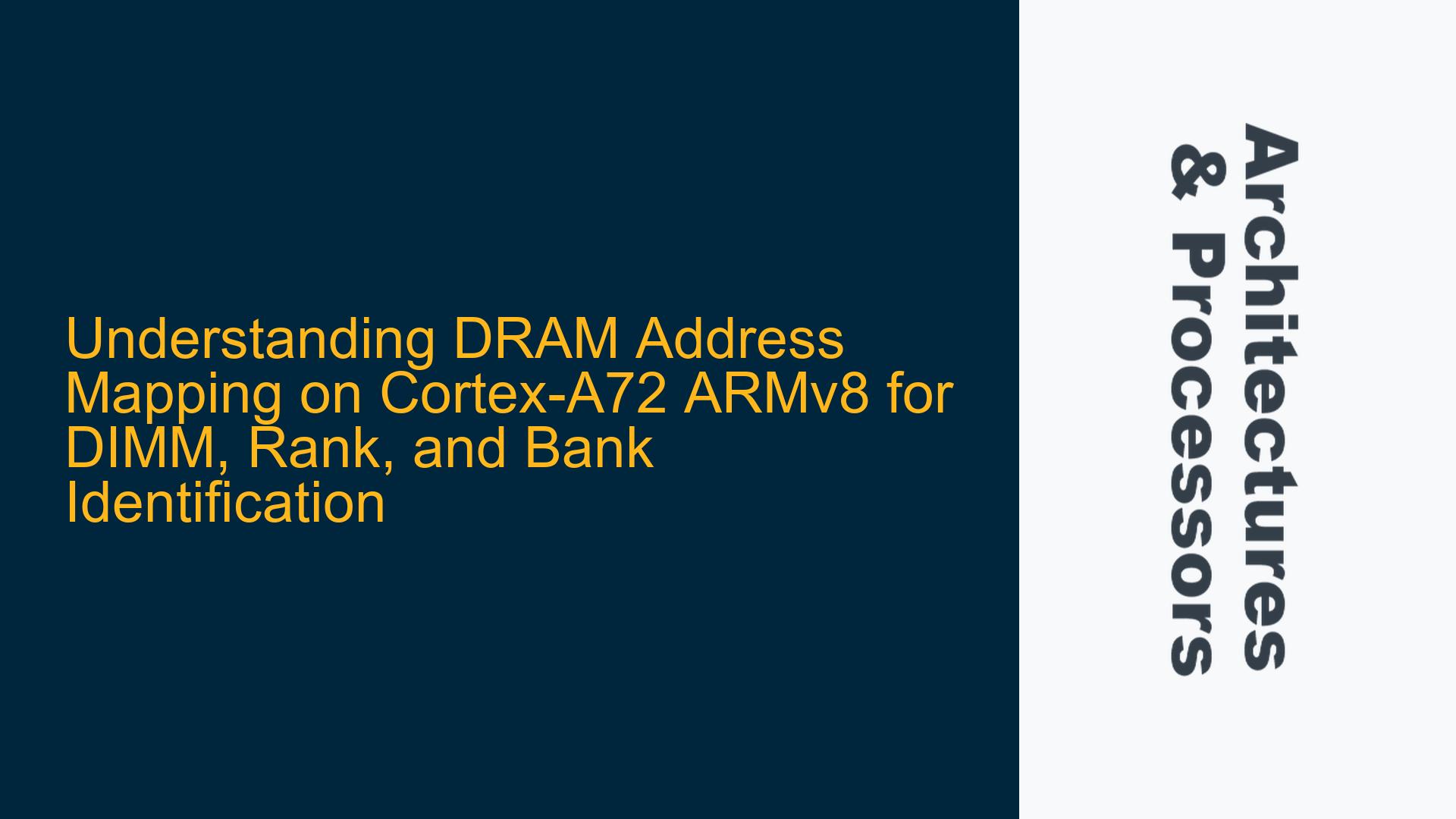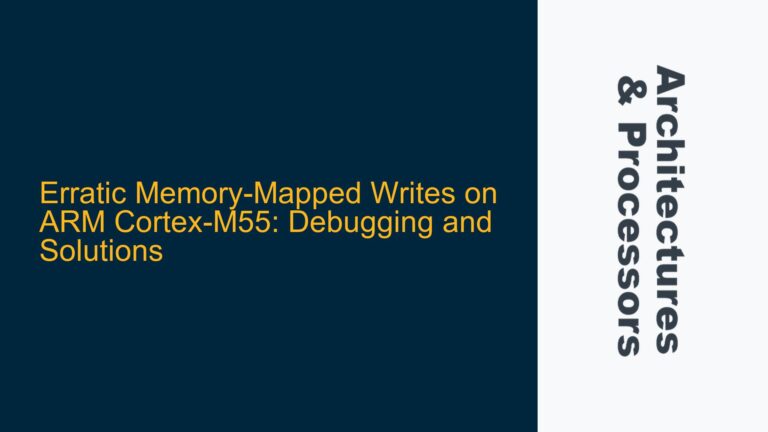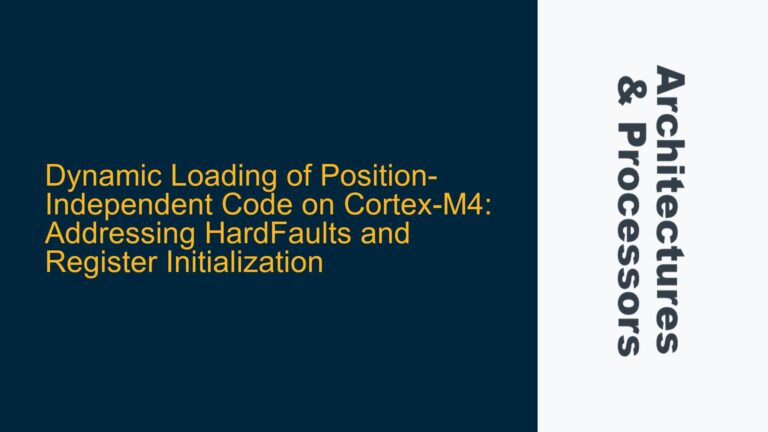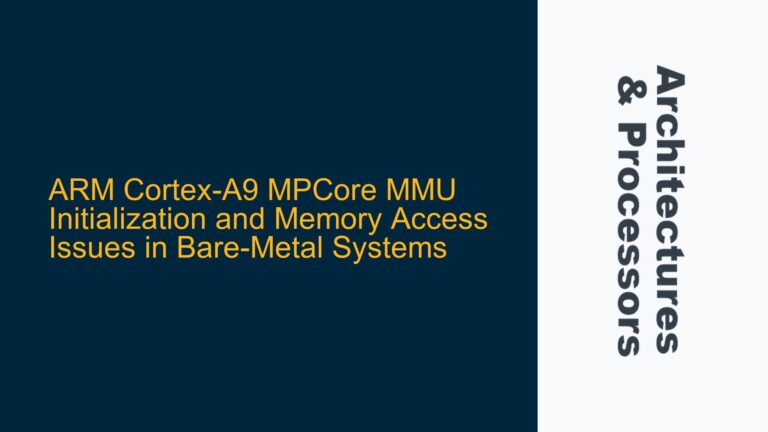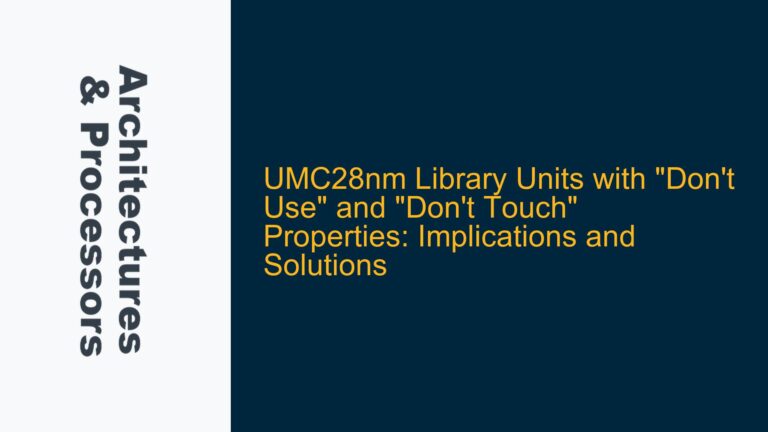DRAM Address Mapping and Physical Memory Hierarchy on Cortex-A72 ARMv8
The Cortex-A72 ARMv8 processor, like many modern ARM cores, relies on a complex memory hierarchy to manage data efficiently. One critical aspect of this hierarchy is the DRAM address mapping, which determines how physical memory addresses are translated into specific locations within the DRAM structure. This mapping is essential for understanding how memory accesses are distributed across DIMMs (Dual In-Line Memory Modules), ranks, and banks. The physical memory hierarchy consists of multiple layers, including DIMMs, ranks, banks, rows, and columns. Each layer has its own addressing scheme, and the mapping between physical addresses and these layers is typically defined by the System-on-Chip (SoC) design.
In the context of the Cortex-A72, the physical address space is divided into segments that correspond to different levels of the DRAM hierarchy. The exact mapping depends on the SoC implementation, as the Cortex-A72 itself does not define the DRAM address mapping. Instead, the SoC’s memory controller handles the translation of physical addresses to DRAM-specific addresses. This translation is crucial for optimizing memory access patterns, minimizing latency, and maximizing bandwidth.
To determine whether two physical memory addresses reside in the same DIMM, rank, or bank, one must understand the specific address mapping scheme used by the SoC. This scheme is typically documented in the SoC’s technical reference manual (TRM). The TRM provides details on how physical address bits are allocated to DIMMs, ranks, banks, rows, and columns. Without this information, it is impossible to definitively determine the relationship between two physical addresses in terms of their DRAM hierarchy.
SoC-Specific DRAM Address Mapping and Its Implications
The DRAM address mapping is inherently SoC-specific because it depends on the memory controller’s design and the configuration of the DRAM modules. The memory controller is responsible for translating physical addresses into DRAM commands, which include selecting the appropriate DIMM, rank, bank, row, and column. The mapping scheme is influenced by factors such as the number of DIMMs, the number of ranks per DIMM, the number of banks per rank, and the organization of rows and columns within each bank.
In most SoCs, the physical address is divided into fields that correspond to different levels of the DRAM hierarchy. For example, certain bits in the physical address might be used to select the DIMM, while other bits select the rank, bank, row, and column. The exact bit allocation varies between SoCs, and it is not standardized across different ARM-based systems. This variability means that the same physical address might map to different DRAM locations on different SoCs, even if they use the same Cortex-A72 core.
The implications of this SoC-specific mapping are significant for performance optimization and debugging. For instance, if two physical addresses map to the same bank but different rows, accessing them sequentially could result in row conflicts, which increase latency. Conversely, if the addresses map to different banks, the memory controller might be able to interleave the accesses, improving throughput. Understanding the DRAM address mapping is therefore essential for optimizing memory-intensive applications and diagnosing performance bottlenecks.
Decoding DRAM Address Mapping from SoC Technical Documentation
To determine whether two physical addresses are in the same DIMM, rank, or bank, one must decode the DRAM address mapping scheme from the SoC’s technical documentation. This process involves identifying the bit fields in the physical address that correspond to each level of the DRAM hierarchy. The following steps outline how to approach this task:
-
Consult the SoC Technical Reference Manual (TRM): The TRM is the primary source of information for the DRAM address mapping scheme. It typically includes a section dedicated to the memory controller, which describes how physical addresses are translated into DRAM commands. Look for diagrams or tables that illustrate the bit allocation for DIMMs, ranks, banks, rows, and columns.
-
Identify the Address Bit Fields: Once you have located the relevant section in the TRM, identify the specific bits in the physical address that are used for each level of the DRAM hierarchy. For example, the TRM might specify that bits [31:28] are used to select the DIMM, bits [27:24] for the rank, bits [23:20] for the bank, and so on. Note that the exact bit positions and widths will vary depending on the SoC.
-
Extract the Relevant Bits from the Physical Addresses: Given two physical addresses, extract the bits corresponding to the DIMM, rank, and bank fields as defined in the TRM. Compare these bits to determine whether the addresses map to the same DIMM, rank, or bank. For example, if the DIMM bits are the same for both addresses, they reside in the same DIMM. Similarly, if the rank and bank bits match, the addresses are in the same rank and bank.
-
Consider the Impact of Address Interleaving: Some SoCs use address interleaving to distribute memory accesses across multiple DIMMs or ranks, improving parallelism and throughput. If interleaving is enabled, the physical address bits used for interleaving must be taken into account when determining the DRAM hierarchy. The TRM should provide details on how interleaving affects the address mapping.
-
Validate the Mapping with Hardware Debugging Tools: If possible, use hardware debugging tools to validate the DRAM address mapping. Many SoCs provide memory controller registers that can be accessed via JTAG or other debugging interfaces. These registers can provide real-time information about how physical addresses are being translated into DRAM commands, allowing you to verify the accuracy of your decoding.
By following these steps, you can determine whether two physical addresses are in the same DIMM, rank, or bank. This information is invaluable for optimizing memory access patterns, diagnosing performance issues, and ensuring reliable system operation. However, it is important to note that the DRAM address mapping can vary significantly between different SoCs, so the process must be repeated for each new platform.
In conclusion, understanding DRAM address mapping on the Cortex-A72 ARMv8 requires a detailed analysis of the SoC’s technical documentation. The mapping scheme is specific to the SoC and defines how physical addresses are translated into DRAM commands. By decoding the address bit fields and considering the impact of interleaving, you can determine the relationship between physical addresses in terms of the DRAM hierarchy. This knowledge is essential for optimizing memory performance and ensuring efficient system operation.
